Documents: Go to download!
User Manual
- User Manual - (English)
- BRFNGBM - Everdure - Specifications Sheet - (English)
- General requirement
- Data Label
- Operating instructions
- Cleaning
- Dress guard
- Troubleshooting
Table of contents
Operating and Maintenance Instructions Gas Heater
General requirement
- The heater shall be installed in accordance with the manufacturer's instructions, local gas fitting regulations, uniform building regulations, municipal building codes, the AGA installation code for gas burning appliances and equipment and any other relevant statutory regulations.
- The heater is intended to be installed as a free standing portable, its portability being restricted by the number of gas outlet points being provided.
- The heater must NOT be BUILT IN.
- Special room ventilation may apply in your particular state. If in doubt, contact your local gas authority.
- Locations where strong draughts occur should be avoided as they may cause unsatisfactory . operationofthe heater.
- The heater should be installed at least 1 metre from flammable materials, e.g. curtains, and to be 150mm clear of sidewalls.
Note
- This appliance has been fully function tested prior to packaging.
- No adjustment is required or available to the user.
- No installation is required apart from connection to gas and electrical supplies. (Fig. 1)
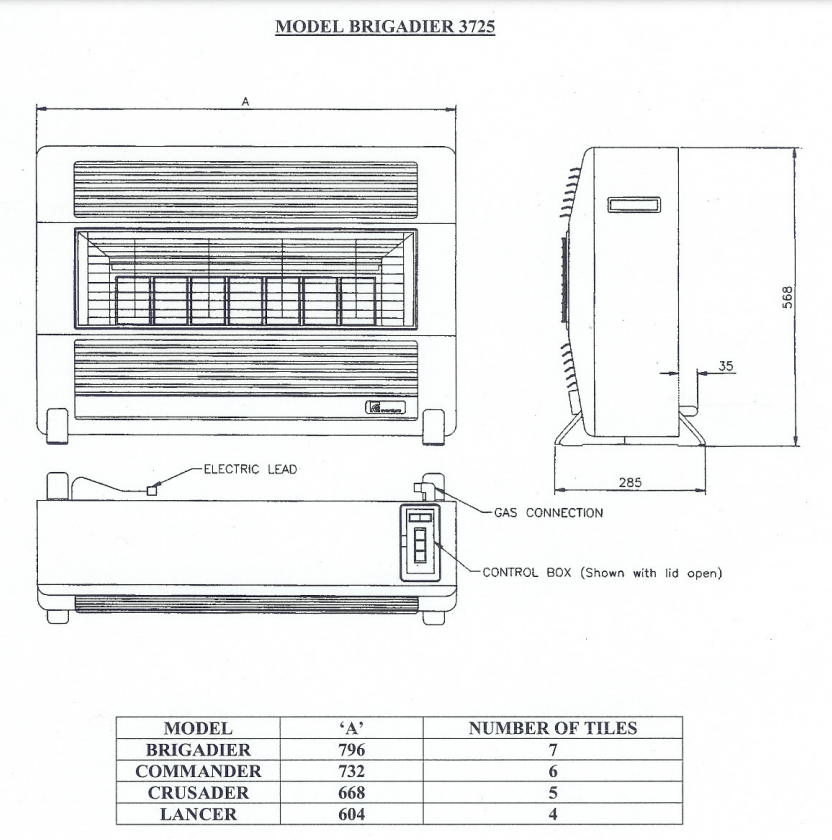
Data Label
The Data Label, as shown below, is located on the inside of the appliance and can be accessed by opening the lower louvre panel. (Fig. 2, Page 7). (Brigadier model shown).
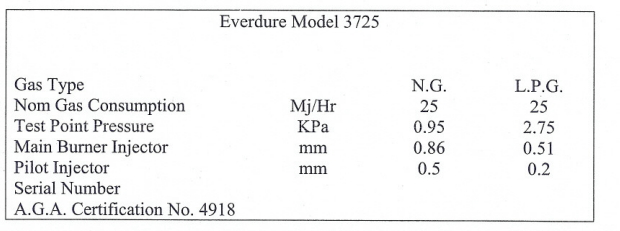
Operating instructions
- GAS SUPPLY: Your heater is fitted with a flexible hose and bayonet coupling which enables you to connect or disconnect it from the gas supply.
- TO CONNECT: Insert the coupling end into the wall socket firmly and rotate the knurled section clockwise to it's locked position.
- TO DISCONNECT: Apply firm forward pressure to the knurled area, rotate anti clockwise and pull towards you. The hose should now come away from the wall socket. Gas is automatically isolated when the hose is disconnected.
- ELECTRICAL SUPPLY: Your heater is fitted with a power supply lead, which should be connected to a standard domestic socket.
- POWER FAILURE: Your Everdure heater will operate quite normally in the event of a power failure. Should the power fail while the heater is operating, the fan will stop. There is however, no need for concern as your heater has been designed to operate satisfactorily with the fan off. (See diagram on next page). Should you wish to ignite your heater during a power failure, follow the instructions under Manual Ignition.
- Note: If your heater has been disconnected for some time, there will be air in the flexible hose. It will therefore take a little longer to ignite when you first turn it on.
- MANUAL IGNITION: The heater may be manually lit by opening the dress guard (see Cleaning) and while holding down the ignition button, apply a lighted longreach match or taper to the pilot. The ignition button needs to be held down for 20 seconds to allow the valve to lock in. Close up the dress guard as described in the cleaning section.
- ABNORMAL OPERATION: As the heater heats up or cools down, expansion or contraction takes place and the occasional 'click' may be heard. This is normal, however, continuous metallic noises, grinding sounds, the smell of gas or any of the symptoms listed on the fault finding chart should be investigated immediately. Turn the appliance off and disconnect the gas and electrical supplies. If the fault cannot be fixed or any doubts exist, contact your nearest EVERDURE service agent or contact Everdure on the telephone number on the front cover of this booklet.
- CONTROLS: The heating controls and fan switches are located under a lid situated on the top right hand side of the heater. Lighting instructions are affixed to the underside of the lid.
- FAN AND FAN SWITCH: The two-speed fan is controlled by the fan switch in the control box, and, as indicated on the control box lid label, the switch has three positions, slow fast and off. Selection of slow or fast fan speed in conjunction with High, Medium or Low heat settings is determined by personal choice and/or heating requirements at the time.
- LIGHTING INSTRUCTIONS: Open the control box lid, depress and hold down the 'ON/IGNITION/LOW' button. This button operates the sparker, which in turn ignites the pilot flame and the low setting burner. It is necessary to hold down the 'ON/IGNITION/LOW' button firmly for at least 20 seconds to allow the gas valve to 'lock in'. If the burner fails to light, repeat the ignition sequence described above.

- The ON/IGNITION/LOW button and the MEDIUMIHIGH button each have two operating positions, which provides three heat settings.
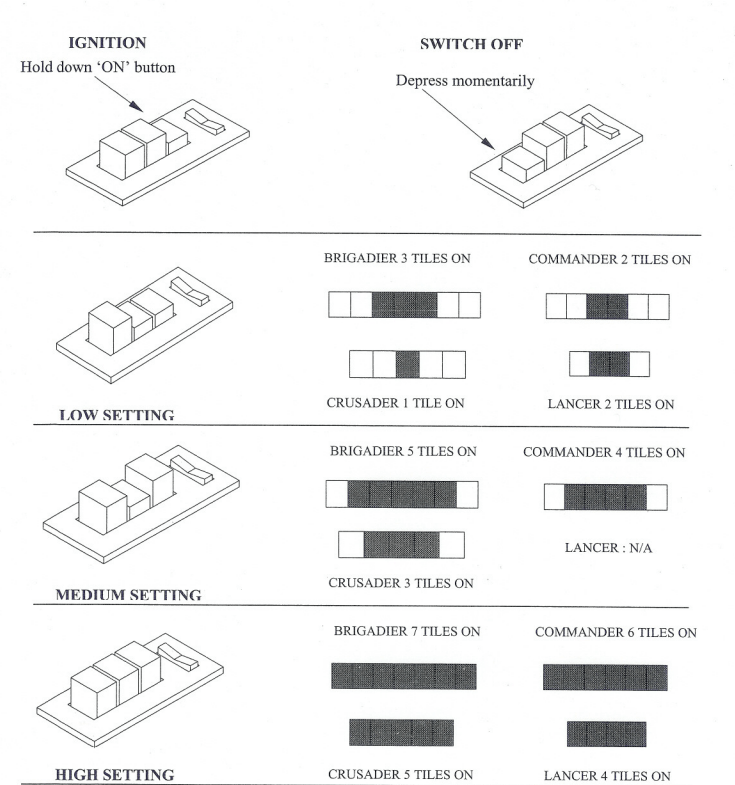
- Low, medium and high settings can be obtained by setting the buttons set as shown in the diagrams above. If you depress the button firmly and it remains in the halfway position, a second depression will return it to the fully up position.
- Please Note: Darkening of the heater tile face is a natural consequence of the gas combustion process.
Warning
- DO NOT place articles on or against this appliance.
- DO NOT use or store inflammable materials near this appliance.
- DO NOT spray aerosols in the vicinity of this appliance while it is in operation.
- DO NOT use this appliance in a marine environment.
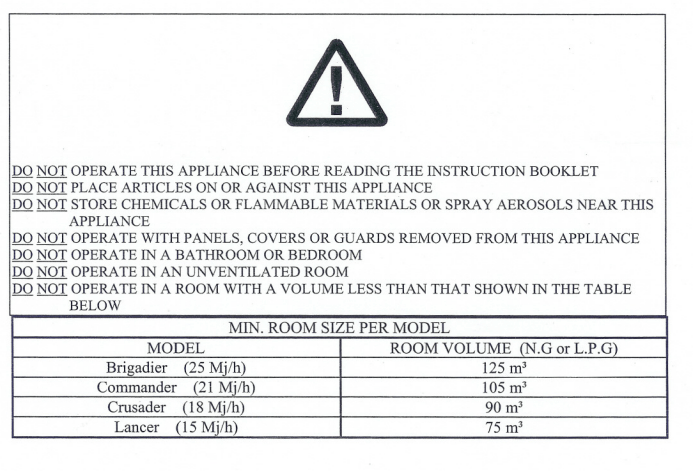
Cleaning
- IMPORTANT: DISCONNECT GAS AND ELECTRICAL SUPPLIES BEFORE CLEANING ANY INTERNAL SURFACES. MALFUNCTIONS CAUSED BY EXCESSIVE LINTING, WILL NOT BE COVERED UNDER WARRANTY. The outer surfaces of the heater should only be cleaned or dusted with a damp cloth. Access to the area in front of the tiles is achieved by opening the dress guard as follows.
- Using both hands, simultaneously apply upward pressure at the bottom left and bottom right of the dress guard, as indicated in FIG 2, and lift up until the wire rods come out of their locations. Ease the bottom of the dress guard forward of the front edge of the reflector and pull down as far as it will go (about 2cms). Pivot the dress guard up until enough space for access is achieved. The dress guard is not removable nor will it open right up. This has been designed like this for safety reasons.
- To close the dress guard to its correct position, pivot it back dovm, lift it up and guide the ends of the wire rods back over their location holes then push down firmly to secure the dress guard in place.
- Cleaning the area in front of the tiles must be done with great care as the burner tiles are fragile and are very easily damaged.
- Access to the underneath of the heater is gained through the lower louvre panel. This panel is hinged at the bottom and is opened by gripping the top louvre blade about 3cms in from each end, pushing down and pulling out (see FIG 2).
- This area needs particular attention and should be gently vacuumed out from time to time. The frequency depends greatly on the environment that the heater is used in, the more furnishings and carpets that are in close proximity to it, the more frequent the cleaning. A check should be made once every month and when dust and fluff become apparent, it should be gently vacuumed out. The fan blades may be rotated by hand whilst vacuuming to ensure all fluff etc, is removed.
Dress guard
- The guard is fitted to this appliance to reduce the risk of fire or injury from bums and no part of it should be permanently removed.
- FOR PROTECTION OF CHILDREN OR THE INFIRM, A SECONDARY GUARD IS REQUIRED.
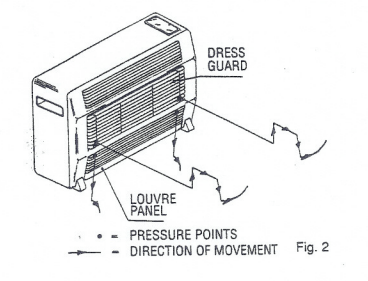
Troubleshooting
Fault finding
1. Spark failure
- Faulty igniter
- Replace
- Incorrect spark gap
- Reset to 4.5mm
- Loose or faulty connections
- Check with meter
2. Failure to ignite even with spark present
- No gas
- Check supply
- Incorrect injectors
- Replace injectors
- Incorrect gas type
- Check gas for which unit was intended
- Air in gas lines
- Purge all lines
- Faulty thermocouple
- Replace ODS
- Faulty tilt switch
- Replace
3. Dull or uneven burners
- Partially blocked injectors
- Clean or replace injectors
- Burner venturi blocked
- Check and clean (possibly insect such as wasp)
- Dirty burner tiles
- Clean with compressed air
4. Burner flashing back
- Cracked burner tile
- Clean with compressed air
- Faulty or incorrect injector
- Replace
- Injector loose
- Replace injector Tighten
5. Very high pilot flame
- Pilot ports partially blocked
- Clean with compressed air or a vacuum cleaner
Please Note: Darkening of the heater tile face is a natural consequence of the gas combustion process.
See other models: NPE2400W

